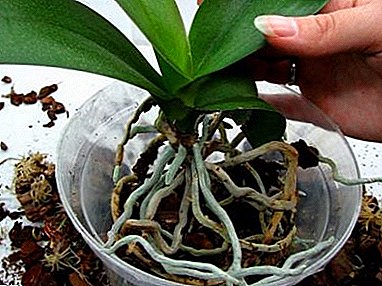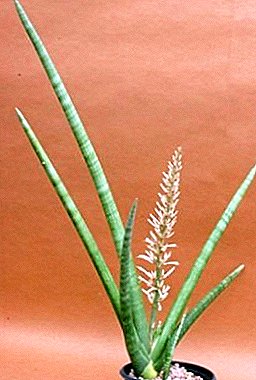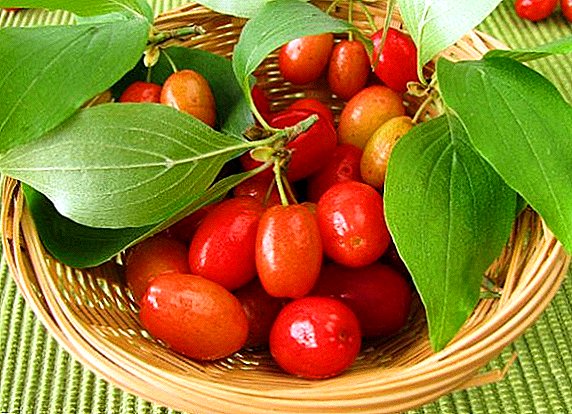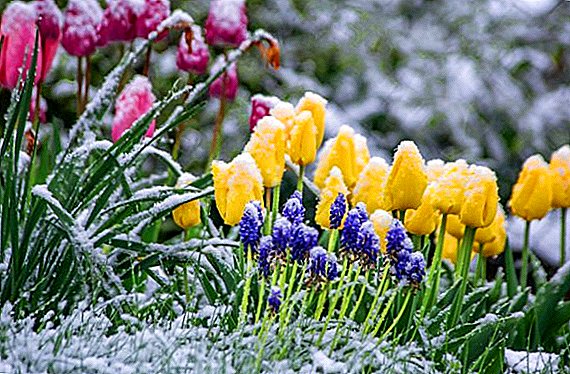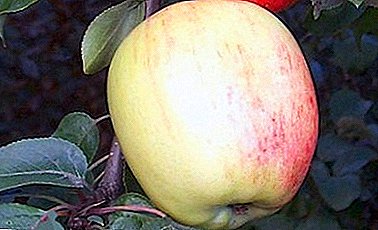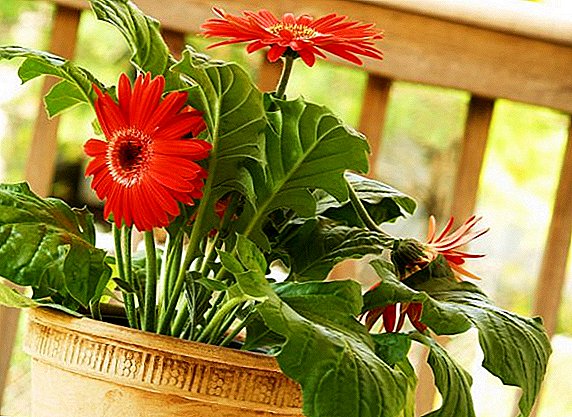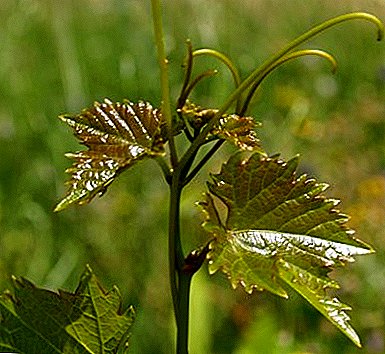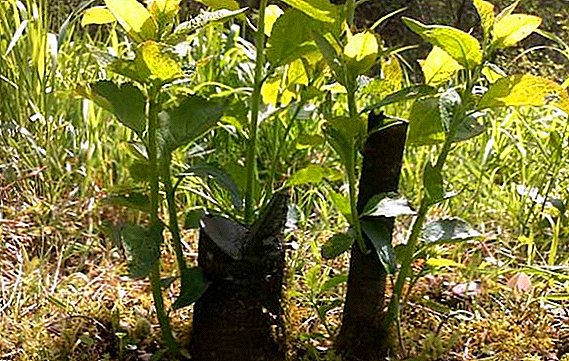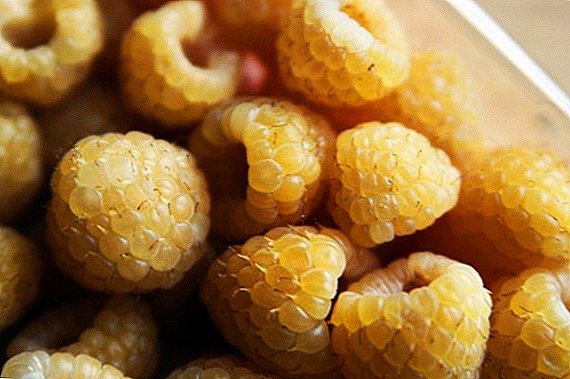 Many are accustomed to seeing only bright pink or red raspberries, and only a small part of farmers know about the existence of black and yellow raspberries. This is a great rarity to meet her in our gardens. This article focuses on the raspberry variety Yellow Giant. Due to the small amount of anthocyanin dyes, it is suitable for use by young children, allergies and pregnant women.
Many are accustomed to seeing only bright pink or red raspberries, and only a small part of farmers know about the existence of black and yellow raspberries. This is a great rarity to meet her in our gardens. This article focuses on the raspberry variety Yellow Giant. Due to the small amount of anthocyanin dyes, it is suitable for use by young children, allergies and pregnant women.
This shrub is a member of the Pink family. Raspberries are grown most often in gardens, but it can be found in the forests, on the banks of rivers and on clearings.
Did you know? Studies show that raspberry scent is often used in lipstick or perfume.
History of breeding raspberry varieties Yellow Giant
The raspberry variety Yellow Giant belongs to remontant varieties, which was bred in 1979. Received it by crossing varieties Maroseyka and Ivanovskaya. This variety is considered the most productive and large-fruited. This was proved by Professor V. V. Kichin, whose company was engaged in breeding this variety. Raspberry Yellow Giant has many advantages, so it is profitable to grow it in your garden for sale or for personal use.
Did you know? Raspberries - an indispensable dessert for those who want to keep their vessels healthy. However, in order to prevent atherosclerosis, hypertension and heart attack, it is desirable to pamper yourself with berries all year round.
Characteristic raspberry yellow giant
We now turn to the description of the raspberry variety Yellow Giant. The berries of this variety are yellow and very large. They reach size with a walnut. The average fetus size is 5 mm. Raspberry Yellow Giant ranks first in terms of yield, but only if you comply with all the conditions of agricultural technology. 
The plant grows to a height of 2 m. To get a good harvest, the tops of the bushes need to be cut. The bush itself is slender and narrow, the spikes on the shoots are straight, medium size.
Also, the berries taste very sweet and aromatic. Soft berry is suitable for fresh consumption, but not suitable for storage or transportation.
The yield of this variety is high - up to 10 t / ha. Raspberry Yellow giant has a mid-term ripening berries. Harvest season - 1.5 months. When grown in the southern regions of the bushes can be harvested for two seasons. In the first season, the berries will be larger and conical.
Pros and cons varieties
Raspberry Yellow giant has many advantages.
- from one bush can collect up to 6 kg of berries;
- berries weighing up to 8 g;
- raspberry fruits from mid-July until the end of October;
- sweet taste;
- juicy pulp;
- pleasant aroma;
- resistance to diseases and the main pests of raspberries.

However, this variety has a disadvantage. Raspberry Yellow giant can not be transported, because the berries lose their presentation. Therefore, it is not grown for sale.
The disadvantages include small thorns on the shoots, and strong root development, since raspberries can grow if root cuttings are not removed in time.
The benefits of raspberry Yellow Giant can be attributed, and winter hardiness, however, this statement is controversial. In regions with severe winters, shoots should be hidden from frost so that the bushes do not freeze. In warm regions, raspberries feel good without shelter.
Timing and site selection
Planted raspberry seedlings in the spring and autumn. In any case, the soil is harvested for 2-3 weeks before planting.
If you decide to plant raspberries in the spring, then prepare a plot in the fall. The place for shrubs should be sunny and protected from drafts. The soil should be neutral, fertile and well drained. Suitable place along the fence or in the corner of the site. 
Important! Before planting raspberries need to disinfect the landing site, if there were predecessors.
Preparatory work and step-by-step process of landing
When buying raspberry seedlings, pay attention to their condition. They should not be mechanical damage, disease or pests, and the roots must be wet.
In order for the root system to settle down better, we recommend that you soak the seedlings in a solution of "Kornevina" or "Heteroauxin" for a couple of hours. To prevent root decay, add the Term, Flint or Ridomil systemic fungicide to the solution.
For good rooting of raspberries, the Yellow Giant should adhere to the agrotechnics of planting.
We offer you two ways of spring planting.
The first method - seedlings are planted in separate holes and raspberries are grown in the form of a shrub of 10 stems.
The second method is planting seedlings in one row in a trench.

In order for the bushes to grow well and bear fruit for 10 years in one place, you need to pay attention to the preparation of the earth mixture for planting. For this, it is necessary to mix the upper fertile layer with rotted manure and matured compost in equal quantities.
You can also apply a mixture of mineral fertilizers. Raspberries will suit double superphosphate with wood ash.
Important! Do not use nitrogen fertilizers. This leads to poor rooting.In the first landing method, you need to dig landing pits (size 0.5 x 0.5). In the center of the pit you need to pour a layer of drainage. It should resemble a small hill.
Before planting, the seedling is dipped into the solution of a mullein for several minutes, after which the root system of the seedling is immersed in a hole on the top of the drainage hill and the roots are straightened. Then you need to fill the roots and compact the ground.
Important! Do not dig the root neck of the seedling. This leads to decay of the root kidney..The root neck should be at ground level or slightly higher.

Raspberry Yellow giant planted most often in a trench way, as the bushes in this case it is convenient to plant and care for them after planting.
To do this, you need to dig a trench, which in depth will resemble a landing pit. Between seedlings there should be a distance of not less than 0.4 m.
At the bottom you need to lay out the compost, superphosphate fertilizer and biohumus. Also, in order to keep the shoots firmly in the ground, plant them near the pegs with a stretched cord.
In this way there is another important point. Bushes better to have pairs. This reduces the possibility of freezing shoots. After you have securely fixed seedlings, they need to fall asleep soil. The upper bud of the stalk must remain above the ground.
We turn to the autumn planting raspberries in open ground. It is held in late September or early October. Before planting in areas that you have allocated for seedlings, you need to spend snow retention.
The distance between the rows when planting raspberries is 2 m, and between the bushes is 50 cm.

At the selected location, you need to dig a groove with a depth of 20 cm, and also pull the cords. If you have not fertilized the soil, you can use mineral fertilizers, mixing them with the ground. Planted raspberries need to be careful not to damage the kidneys. Root the system before planting dip in a clay mash.
After planting, raspberries must be poured (1 bucket per bush), and the plant must be mulched with humus, soil, or compost.
Competent care - the key to a good harvest
Growing raspberries The yellow giant does not end with just a competent fit, as it needs to provide proper care.
Did you know? Pliny cultivated raspberries in ancient Rome by accidentally eating this berry in Crete.
Prevention and protection against pests and diseases
Good harvest can be obtained not only with proper planting. We also have to worry about pests and diseases that can affect raspberries and reduce the yield of shrubs.
We present to your attention the list of pests and measures to combat them:
- Raspberry stem gallitz. This parasite damages the raspberry stalks and causes noticeable swelling on the lower and middle part of the stalks. The larvae hibernate in these swellings, and at the end of May they turn from pupae into mosquitoes. Adults lay eggs on young shoots, and barrel-shaped swellings form in damaged areas a month later. Insect damages about 70% of raspberry shoots.
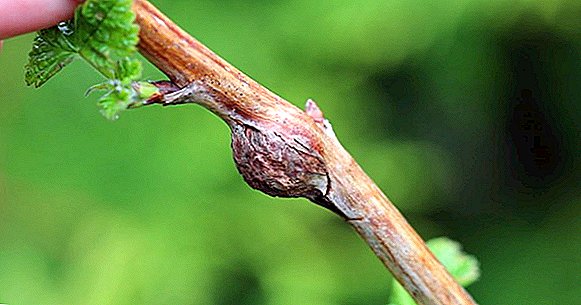
You can fight it in spring and autumn. You need to cut and burn damaged shoots and stems. Since this may not be enough, you can treat raspberries with chemicals ("Alatar", "Fufanon", "Iskra-M", "Aktellik") in the spring. To protect the suitable simple spraying shrubs. It is better to alternate drugs.
- Raspberry walnuts. The parasite damages the raspberry stalks, causes swelling and cracking of the tissues. Control measures are the same as with gall midges.
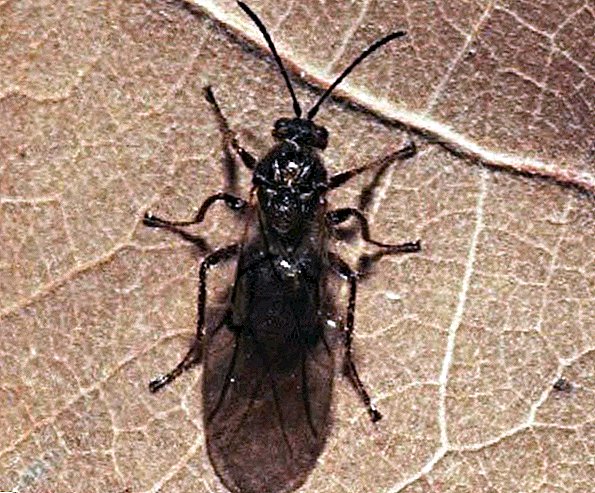
- Raspberry shoots aphid. It damages raspberries, which is located in shaded areas. Parasites cause leaves to curl, retard plant growth, shorten internodes and cause curvature of shoots.
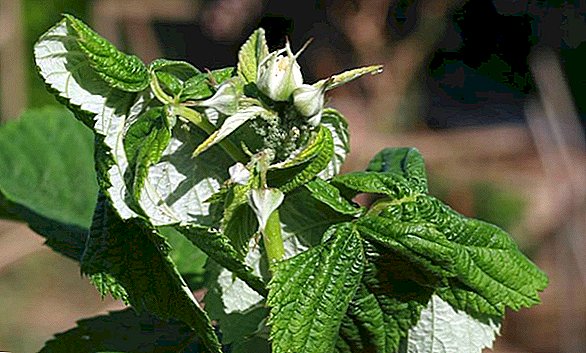
Insect entomophages help to get rid of aphids during the growing season. You can also use chemicals, but only if the buds have not yet dissolved or you have already harvested. Apply a solution of "Nitrafen", "Malathion" or another insecticide.
- Raspberry strawberry weevil. If you notice that the pedicels are devoid of buds, then know that this is a weevil.

It is necessary to fight it during budding, using drugs that are used in stem gallitsa.
Go to the disease.
- Chlorosis raspberry. If you start to turn yellow raspberries, it can be caused by a disease that nematodes suffer. Yellowness begins to appear on the leaf between the veins, then it spreads on the whole leaf, and it gradually deforms. Raspberry berries become small and dry quickly.

In this case, various chemical sprays will not help. It is better to immediately dig up the affected plant and burn it.
- Curly raspberries. It is a viral disease in which the leaves become shallow, stiff and wrinkled, and the underside of the leaf darkens. The berries of the affected bush will be sour, and the plant itself may die within 3 years.
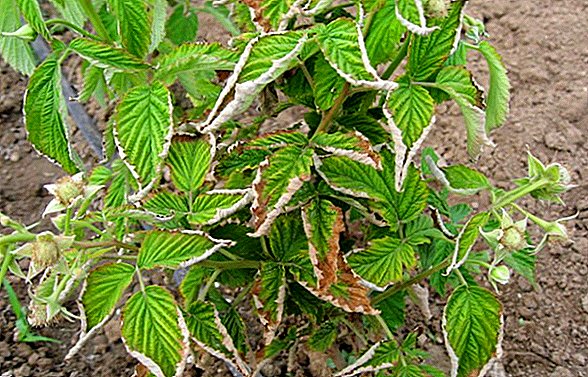
It is impossible to cure the disease, so it is better to immediately remove the plant from the site and burn it.
- Mycoplasma disease. This disease is also called witch broom. In case of defeat by this disease, the plant releases many small shoots, which subsequently do not bear fruit.
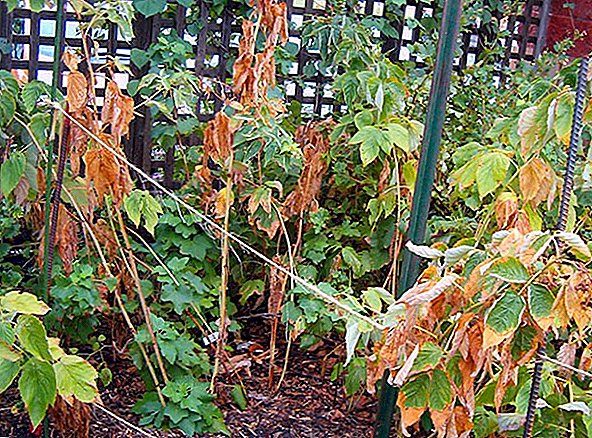
Such a copy is better to destroy immediately, so that the disease does not go to other bushes.
- Rust raspberry. In this case, the raspberry dries, and dark spots appear on the underside of the leaf. Then the leaves fall off, and brown ulcers form on the stems. This disease cannot be cured, so destroy the plant right away.
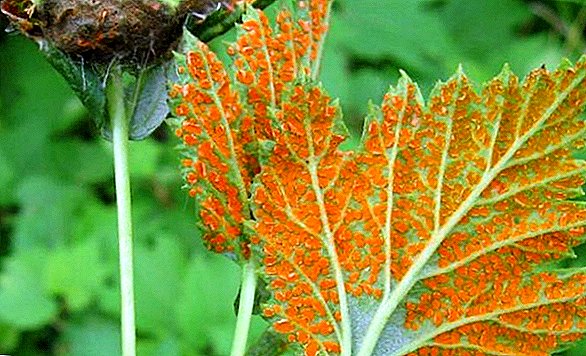
To prevent infection, process the raspberries with a 1% solution of Bordeaux liquid.
- Raspberry spotting. On the young raspberry shoots appear purple spots that blur and darken around the edges, acquiring a reddish brown color. When the spots merge together, their surface partially cracks, and the shoots break. In the future, the kidneys you will not wait for them.
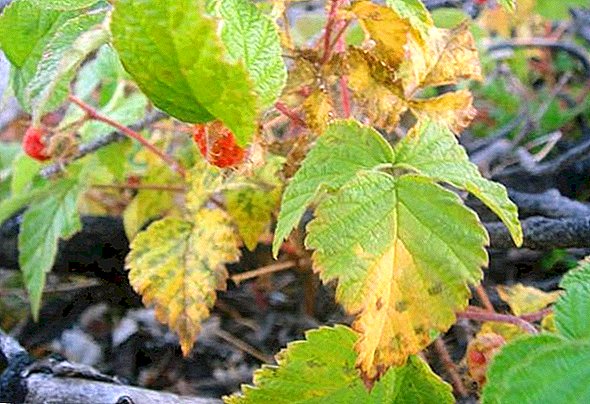
It is necessary to destroy infected plants and treat other bushes with a 1% solution of Bordeaux mixture.
The abundance of irrigation
Raspberry Yellow Giant loves water. Lack of moisture causes weakened growth and yield reduction.
To get a rich harvest, you need to conduct abundant watering of raspberries. This should be done 2 times a week before flowering, during the formation of fruits and during the ripening of the crop. Water consumption for one irrigation - 4 buckets per 1 square. m
It is important to water the plant in the fall. This should be done abundantly, that is, about 6 buckets per square meter. m
Did you know? A handful of raspberries is an excellent antidepressant and will easily relieve the depressed state: its constituent copper will quickly bring your nervous system in order.
Fertilization
Raspberry Care The yellow giant does not end with watering and protection from pests and diseases. The yield and size of raspberry berries depend on the thickness of the stem of a bush, and the growth and development of shoots stimulate additional feeding.

Raspberry is better to fertilize with organic i.e., manure, slurry, peat compost or poultry manure. It is better to add top dressing from the third year of raspberry life.
Before fruiting, a young bush can be fed with nitrogenous fertilizers, such as ammonium nitrate (calculated at 20 g / sq. M). After the early spring pruning, 50 g / sq. m "Nitroammofoski."
To increase the yield, you can use liquid manure or slurry (calculation or 1:10 or 1:20).
Subtleties trimming
Pruning yellow raspberries spend most often in the fall. It helps to prepare the shrubs for the winter.
In the fall, you need to remove two-year shoots, but only if you have already harvested the crop. This is done because next year these same shoots will no longer bear fruit. After pruning raspberries will direct all the power to the growth of new shoots. They will give you a harvest next year. It is better to burn all remote shoots.
You can also cut off the shoots frozen in winter in the spring.

You need to prune shoots to a healthy bud. You also need to remove the sick, broken and underdeveloped branches. There should be 15 shoots on one raspberries. You should not worry about the yield, as the number of berries will decrease, but they will be quite large.
Shelter for the winter
In areas of the middle band the raspberry stalks freeze slightly. Therefore, it is better to bend them to the ground as low as possible and to tie them together in a bundle. Do it better in the fall. The root system can be mulched and covered with snow. The roots do not freeze. You also need to pierce the frost on the snow cover. This is necessary to ensure that the wintering raspberries receive an inflow of air.
If the snow does not fall, raspberries need to cover the covering material, which is removed in the spring. In April, it is better not to raise the bush immediately. You must first get rid of the injured shoots during the winter and only then pick up the shoots and fix them on the trellis.
Terms of ripening and harvesting
The fruits of raspberries ripen by mid-July and bear fruit until the first frost. Then the harvest begins raspberry. It is better to do this with garden gloves, in order not to damage the hands with spikes. From one bush per season you can collect up to 6 kg of raspberries. It is better to collect raspberries in the early morning, but not after the rain, as the berry becomes limp.
Transfer the collected fruit from one container to another is not worth it, as they are soft.
You can make jam, confiture or jam from yellow raspberry.
It is better not to freeze the berries, as they have a fragile consistency. Better pereteret raspberries with sugar.
Raspberry Yellow Giant has a high yield, sweet taste and aroma. If you follow all the rules of agricultural technology, then you get a bountiful harvest of yellow berries and you can enjoy them until the frost.











